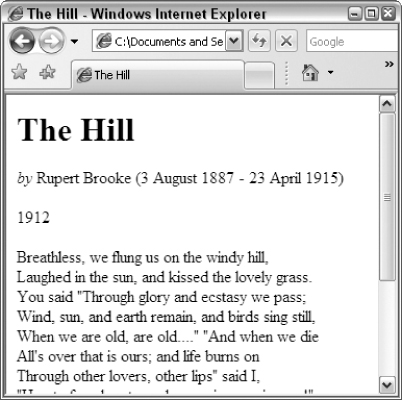XSLT 2.0 and XPath 2.0 Programmer's Reference, 4th Edition (75 page)
Read XSLT 2.0 and XPath 2.0 Programmer's Reference, 4th Edition Online
Authors: Michael Kay

However, I wouldn't normally recommend this approach. Creating a copy of the input document is likely to be expensive. It's better to do the validation on the fly while the input document is being parsed in the first place.
The value of the type
type attribute in this example, like the type named in the
attribute in this example, like the type named in the instance of
instance of expression in the previous example, is a type that's defined in a schema. Like any other type that's referred to by name in a stylesheet, it must be defined in a schema that has been imported using the
expression in the previous example, is a type that's defined in a schema. Like any other type that's referred to by name in a stylesheet, it must be defined in a schema that has been imported using the
Here's an example of a complete stylesheet written to process a validated source document.
Example: Validating the Source Document
This example shows how a stylesheet can make use of the schema for the source document.
Source
The source document is a poem such as
theHill.xml
, which starts:
xsi:schemaLocation=“http://poetry.org/ns poem.xsd”
xmlns:xsi=“http://www.w3.org/2001/XMLSchema-instance”>
The
xsi:schemaLocation
attribute tells the processor where to find a schema for this document. This isn't needed with Saxon, which will validate the document against the schema imported into the stylesheet, provided that validation is requested on the command line. With AltovaXML, the
xsi:schemaLocation
attribute acts as an implicit request for document validation, and is therefore necessary for this example to work.
The
xsi namespace
is defined in the XML Schema specification and contains four attributes:
xsi:schemaLocation, xsi:noNamespaceSchemaLocation, xsi:type, and xsi:nil
. The prefix
xsi
is conventional, but the namespace URI must be
http://www.w3.org/2001/XMLSchema-instance
.
Schema
The schema for poems is in
poem.xsd
:
elementFormDefault=“qualified” targetNamespace=“http://poetry.org/ns”
xmlns:p=“http://poetry.org/ns”>
Stylesheet
The following stylesheet is in
poem-to-html.xsl
. It relies on the source document being validated.
xmlns:xsl=“http://www.w3.org/1999/XSL/Transform”
xmlns:xs=“http://www.w3.org/2001/XMLSchema”
xpath-default-namespace=“http://poetry.org/ns”
exclude-result-prefixes=“xs”>
schema-location=“poem.xsd”/>
by
(
-
Notice how the template rules in this example are matching nodes by their type. The first rule catches unvalidated documents to report an error. The second rule matches the document node of a poem, while the third matches any element that is typed as a
gendate
—a user-defined type that can be an
xs:date
, an
xs:gYearMonth
, or an
xs:gYear
. There are three elements in the schema that use this type, but we don't need to name them in the stylesheet; the rule can be used to format any element of this type, regardless of its name.
Output
This example can be run using Saxon-SA, by using the command (on one line):
java net.sf.saxon.Transform -val:strict -s:theHill.xml 
-xsl:poem-to-html.xsl -o:theHill.html
It can also be run using the AltovaXML 2008 processor, with the command:
AltovaXML -in theHill.xml -xslt2 poem-to-html.xsl
Figure 4-2
shows what the output looks like in the browser.
Try some experiments with this, so that you can see what effect schema-aware processing has when you make errors. For example, change the path expression on line 23 from poem/author/name
poem/author/name to
to poem/poet/name
poem/poet/name . Saxon-SA gives you the warning:
. Saxon-SA gives you the warning:

